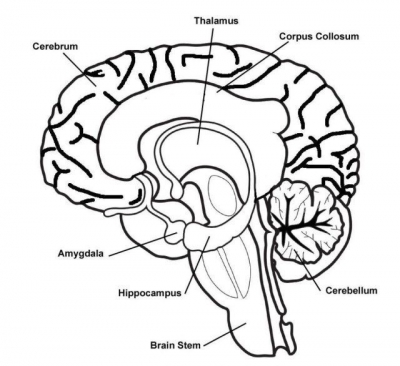
If we could take the brain part, we would see that it has two distinct, very similar halves, called hemispheres. The largest part of the brain, the cerebrum, deals with our thoughts, speech, and senses. The brain has many other areas, and scientists are still not sure about the exact functions of all of them.
Right hemisphere
The right side of the brain controls the left side of the body. A right hemisphere dominant person excels in arts. It is visual and intuitive. It is also called the analog brain.
Corpus callosum
The corpus callosum is a large white matter tract that connects the two hemispheres of the brain. It is an incredibly important structural and functional part of the brain. This connects the two halves of the brain, enabling them to swap information.
Putamen
The putamen is a large structure located within the brain. It is involved in a very complex feedback loop that prepares and aids in movement of the limbs. The putamen helps control movements.
Caudate nucleus
The caudate nucleus plays a vital role in how the brain learns, specifically the storing and processing of memories. It works as a feedback processor, which means it uses information from past experiences to influence future actions and decisions. This helps to maintain long-term and short-term memory.
Globus pallidus
The globus pallidus is a structure in the brain involved in the regulation of voluntary movement.[7] It is part of the basal ganglia, which, among many other things, regulate movements that occur on the subconscious level. This helps to make movements smooth.
Pituitary gland
The pituitary gland is located in the brain, between the hypothalamus and the pineal gland, just behind the bridge of the nose. It is about the size of a pea and is attached to the brain by a thin stem of blood vessels and nerve cell projections. This gland produces different hormones.
Cerebellum
The cerebellum is located behind the top part of the brain stem (where the spinal cord meets the brain) and is made of two hemispheres (halves). The cerebellum receives information from the sensory systems, the spinal cord, and other parts of the brain and then regulates motor movements. This helps the body to balance.
Brainstem
The brainstem (brain stem) is the distal part of the brain that is made up of the midbrain, pons, and medulla oblongata. Each of the three components has its own unique structure and function. The brainstem controls basic body functions such as breathing and heart rate.
Ventricle
The ventricles of the brain are a communicating network of cavities filled with cerebrospinal fluid (CSF) and located within the brain parenchyma. One or four areas that hold cerebrospinal fluid, which brings nutrients to the brain.
Left hemisphere
The left side of the brain controls the right side of the body. If the left side of the brain is dominant, the person is logical and more academically inclined.
Cerebrum
The cerebrum is the largest part of the brain, located superiorly and anteriorly in relation to the brainstem. This is the thinking and feeling centre of the brain.
Thalamus
The thalamus is a small structure within the brain located just above the brain stem between the cerebral cortex and the midbrain and has extensive nerve connections to both. The thalamus processes and passes on information from the sense organs.
Brain folds
These create a larger surface to pack in neurons for maximum processing power. The peak of such a fold is called a gyrus (plural: gyri), and its trough is called a sulcus (plural: sulci). The neurons of the cerebral cortex reside in a thin layer of gray matter, only 2–4 mm thick, at the surface of the brain.
Amygdala
The amygdala (Latin, corpus amygdaloideum) is an almond-shape set of neurons located deep in the brain’s medial temporal lobe. An area that affects emotions.
Hippocampus
Hippocampus is a brain structure embedded deep in the temporal lobe of each cerebral cortex. It is an important part of the limbic system, a cortical region that regulates motivation, emotion, learning, and memory. This creates and stores long-term memories.
Picture Credit : Google

